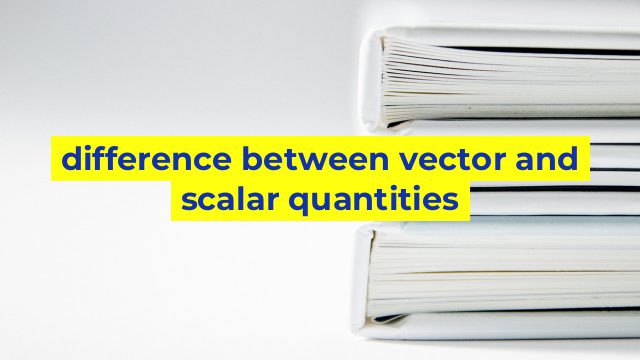Understanding the Difference Between Vector and Scalar Quantities
When we talk about quantities, we often classify them as either vector or scalar. But what distinguishes these two types of quantities, and why is it important to differentiate between them? In this article, we’ll take a closer look at the key differences between vector and scalar quantities in order to better understand their implications in physics and other fields.
What Are Scalar Quantities?
Scalar quantities are those that are described solely by magnitude or size, without regard to direction. Examples of scalar quantities include time, temperature, mass, energy, and distance. These quantities can be added, subtracted, multiplied, and divided, just like ordinary numbers. When you perform operations on scalar quantities, you simply add, subtract, multiply or divide their magnitudes.
What Are Vector Quantities?
Vector quantities, on the other hand, are characterized by both magnitude and direction. Examples of vector quantities include velocity, force, acceleration, and displacement. Vector quantities are often represented graphically as arrows, with the length of the arrow indicating the magnitude of the vector and the direction of the arrow representing its direction.
When performing operations on vector quantities, it’s important to take both magnitude and direction into account. Adding or subtracting two vectors involves adding or subtracting their components in each direction, while multiplying or dividing a vector by a scalar involves multiplying or dividing its magnitude.
Why Is the Distinction Important?
The difference between vector and scalar quantities is important in a number of fields, including physics, engineering, and mathematics. In physics, for example, understanding the distinction between scalar and vector quantities is necessary for modeling the behavior of objects in motion, where both magnitude and direction play a role. Engineers often use vector quantities to design and analyze systems, such as mechanical or electrical systems, in order to ensure that they function properly.
In mathematics, vector quantities are often used to represent geometric concepts, such as lines, planes, and transformations in space. In addition, vector calculus, which deals with the calculus of vector fields and their integrals, is an important tool in areas such as fluid dynamics and electromagnetism.
In conclusion, while scalar and vector quantities may seem similar, their differences are fundamental and significant. Understanding these distinctions is important for anyone working in fields where precise measurement, modeling, or analysis is required. By keeping the two types of quantities distinct and understanding how to manipulate them appropriately, we can achieve greater accuracy and insight, both in theory and in practice.
Table difference between vector and scalar quantities
| Quantity Type | Definition | Examples |
|---|---|---|
| Vector Quantity | A physical quantity that has both magnitude and direction. | Velocity, acceleration, force, displacement, momentum |
| Scalar Quantity | A physical quantity that has only magnitude. | Mass, time, speed, energy, temperature, pressure |
